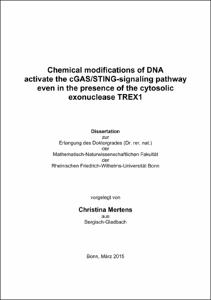Mertens, Christina: Chemical modifications of DNA activate the cGAS/STING-signaling pathway even in the presence of the cytosolic exonuclease TREX1. - Bonn, 2015. - Dissertation, Rheinische Friedrich-Wilhelms-Universität Bonn.
Online-Ausgabe in bonndoc: https://nbn-resolving.org/urn:nbn:de:hbz:5n-41258
Online-Ausgabe in bonndoc: https://nbn-resolving.org/urn:nbn:de:hbz:5n-41258
@phdthesis{handle:20.500.11811/6533,
urn: https://nbn-resolving.org/urn:nbn:de:hbz:5n-41258,
author = {{Christina Mertens}},
title = {Chemical modifications of DNA activate the cGAS/STING-signaling pathway even in the presence of the cytosolic exonuclease TREX1},
school = {Rheinische Friedrich-Wilhelms-Universität Bonn},
year = 2015,
month = sep,
note = {To recognize pathogen threats, the innate immune system is equipped with pattern recognition receptors (PRRs) that bind to and are activated by pathogen-associated molecular patterns (PAMPs). Most PAMPs are conserved across species of microbes but at the same time not present in the host, allowing for the efficient discrimination between endogenous and foreign material. However, viruses rely on the host transcriptional and translational machinery to produce every viral component, and therefore do not really contain foreign molecules. It has become apparent that viruses instead are mainly detected via their nucleic acid genomes in the endosomes or cytosol of the host cell. However, virus sensing based on their nucleic acids comes at the risk of erroneous recognition of self-DNA - a process that leads to autoinflammation and possibly autoimmune disease. In particular, the receptor cGAMP synthase (cGAS) detects the mere presence of any DNA in the cytosol by binding its sugar phosphate backbone, and thus shows no apparent preference for sequence or specific molecular structures.
Within this work, evidence is provided that specific damage-associated DNA modifications strongly enhance cGAS-dependent innate immune activation. DNA modifications occurring after UV irradiation, incubation with cytostatic agents, ROS exposure or as a consequence of neutrophil extracellular trap (NET) release were shown to potentiate the interferon (IFN) release in response to cytosolic DNA. However, this differential immune response was not due to higher affinity binding of the modified DNA to cGAS itself, but rather due to an impaired degradation by the cytosolic exonuclease TREX1. Resistance to TREX1 promoted an accumulation of the modified DNA in the cytosol, leading to a prolonged activation of the cGAS/STING-signaling pathway and the release of type I IFN.
One well-known autoimmune disease driven by autoantibodies recognizing double-stranded DNA is lupus erythematosus (LE). Using the lupus-prone mouse model MRL/lpr, UV-damaged DNA (UV-DNA) was shown to be able to induce lupus-like lesions. Thus, UV-DNA could be a potential cause for the phototoxicity often observed in LE patients. Moreover, intravenous administration of UV-DNA induced a type I IFN response in MRL/lpr mice, which could be linked to F4/80-positive monocytes/macrophages.
Together, these data show that under certain conditions self-DNA is transformed into a damage-associated molecular pattern (DAMP) that provides an additional layer of information to distinguish danger and damage from healthy states},
url = {https://hdl.handle.net/20.500.11811/6533}
}
urn: https://nbn-resolving.org/urn:nbn:de:hbz:5n-41258,
author = {{Christina Mertens}},
title = {Chemical modifications of DNA activate the cGAS/STING-signaling pathway even in the presence of the cytosolic exonuclease TREX1},
school = {Rheinische Friedrich-Wilhelms-Universität Bonn},
year = 2015,
month = sep,
note = {To recognize pathogen threats, the innate immune system is equipped with pattern recognition receptors (PRRs) that bind to and are activated by pathogen-associated molecular patterns (PAMPs). Most PAMPs are conserved across species of microbes but at the same time not present in the host, allowing for the efficient discrimination between endogenous and foreign material. However, viruses rely on the host transcriptional and translational machinery to produce every viral component, and therefore do not really contain foreign molecules. It has become apparent that viruses instead are mainly detected via their nucleic acid genomes in the endosomes or cytosol of the host cell. However, virus sensing based on their nucleic acids comes at the risk of erroneous recognition of self-DNA - a process that leads to autoinflammation and possibly autoimmune disease. In particular, the receptor cGAMP synthase (cGAS) detects the mere presence of any DNA in the cytosol by binding its sugar phosphate backbone, and thus shows no apparent preference for sequence or specific molecular structures.
Within this work, evidence is provided that specific damage-associated DNA modifications strongly enhance cGAS-dependent innate immune activation. DNA modifications occurring after UV irradiation, incubation with cytostatic agents, ROS exposure or as a consequence of neutrophil extracellular trap (NET) release were shown to potentiate the interferon (IFN) release in response to cytosolic DNA. However, this differential immune response was not due to higher affinity binding of the modified DNA to cGAS itself, but rather due to an impaired degradation by the cytosolic exonuclease TREX1. Resistance to TREX1 promoted an accumulation of the modified DNA in the cytosol, leading to a prolonged activation of the cGAS/STING-signaling pathway and the release of type I IFN.
One well-known autoimmune disease driven by autoantibodies recognizing double-stranded DNA is lupus erythematosus (LE). Using the lupus-prone mouse model MRL/lpr, UV-damaged DNA (UV-DNA) was shown to be able to induce lupus-like lesions. Thus, UV-DNA could be a potential cause for the phototoxicity often observed in LE patients. Moreover, intravenous administration of UV-DNA induced a type I IFN response in MRL/lpr mice, which could be linked to F4/80-positive monocytes/macrophages.
Together, these data show that under certain conditions self-DNA is transformed into a damage-associated molecular pattern (DAMP) that provides an additional layer of information to distinguish danger and damage from healthy states},
url = {https://hdl.handle.net/20.500.11811/6533}
}






